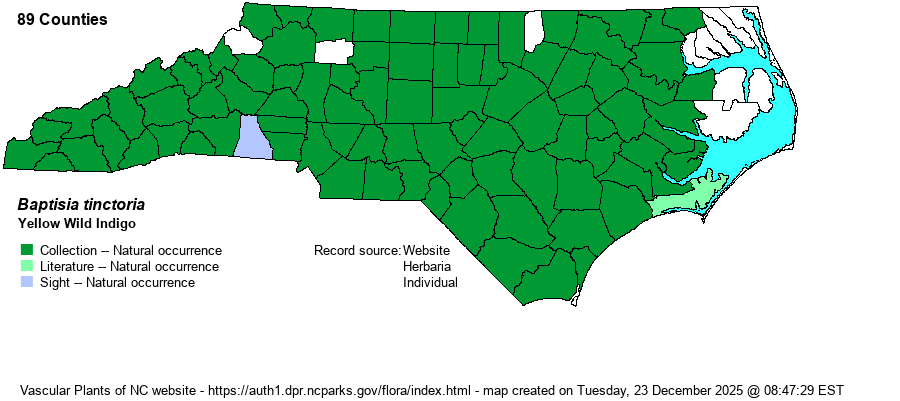| Author | (L.) Ventenat | |
| Distribution | Found nearly throughout the state, but essentially absent in the far eastern counties. No known records east of Gates, Washington, and Pamlico counties, including well-worked Hyde and Dare counties.
This is a widespread north-south species, but it has a narrow east-west range. It occurs from southern ME and mainly west to southern MI, and then south to southern GA. Scarce in most of the Great Lakes states and in most of KY and western TN. Not yet recorded from AL or FL. | |
| Abundance | Frequent to common in the state, other than being scarce to absent toward the far eastern counties. The NCNHP's State Rank of S4 surely should be S5, as it has been recorded from at least 88 counties. | |
| Habitat | This is our only statewide Baptisia species, and not surprisingly it has the widest habitat choices. It favors dry to rather dry and sunny places, or in partial shade. It is most often found along dry wooded margins and roadbanks, sandy openings in woods, in powerline clearings or old fields, drier pine flatwoods, and various sandhill habitats. | |
| Phenology | Has a wide blooming period, mainly in late spring and early summer (May and June), but can flower from April into August; fruits from July to November. | |
| Identification | This Baptisia looks quite a bit different from the others in NC, in its much smaller leaves. Like others, it grows to about 2-3 feet tall and is somewhat bushy with its spreading branches, but as the leaves are quite small, it has an open and somewhat "skinny" look. The scattered alternate leaves are trifoliate like others, but the 3 leaflets (obovate in shape) are only about 2/3-inch long and somewhat narrower. At the ends of scattered branches grow the flower clusters, but the racemes have only widely scattered flowers, each bright yellow and only about 2/5-inch long. Even though the flowers are relatively small and clusters are sparely flowered, there are enough such racemes on the plant that when in full bloom, the plant can light up in bright yellow, with many dozens of flowers "lit up" all over the top half of the plant, rather than in discrete spires like in other Baptisia species. Also unlike others in the genus, the pods are quite small, being rounded but only about 1/3-inch long, not easily catching attention. Fortunately, owing to its widespread occurrence in the state, it is often seen, but seldom in large numbers at any one site. You should be able to identify this wild indigo without flowers or fruit, as the rather "tiny" trifoliate leaves on a wide-spreading 2-3 feet tall herb should be sufficient. | |
| Taxonomic Comments | None
| |
| Other Common Name(s) | Honesty-weed, Rattleweed, Northern Wild Indigo, Horsefly-weed. This common species has gone for over 100 years of dozens and dozens of field guides and other references without an established common name! Some guides just call it "Wild Indigo". A few, including NatureServe, name it as Yellow Wild Indigo, and though there are quite a few other Baptisia species in the country with yellow flowers, others tend to have different names already. | |
| State Rank | S4 [S5] | |
| Global Rank | G5 | |
| State Status | | |
| US Status | | |
| USACE-agcp | | |
| USACE-emp | | |

